brake INFINITI QX80 2020 Towing Guide
[x] Cancel search | Manufacturer: INFINITI, Model Year: 2020, Model line: QX80, Model: INFINITI QX80 2020Pages: 25, PDF Size: 0.62 MB
Page 17 of 25
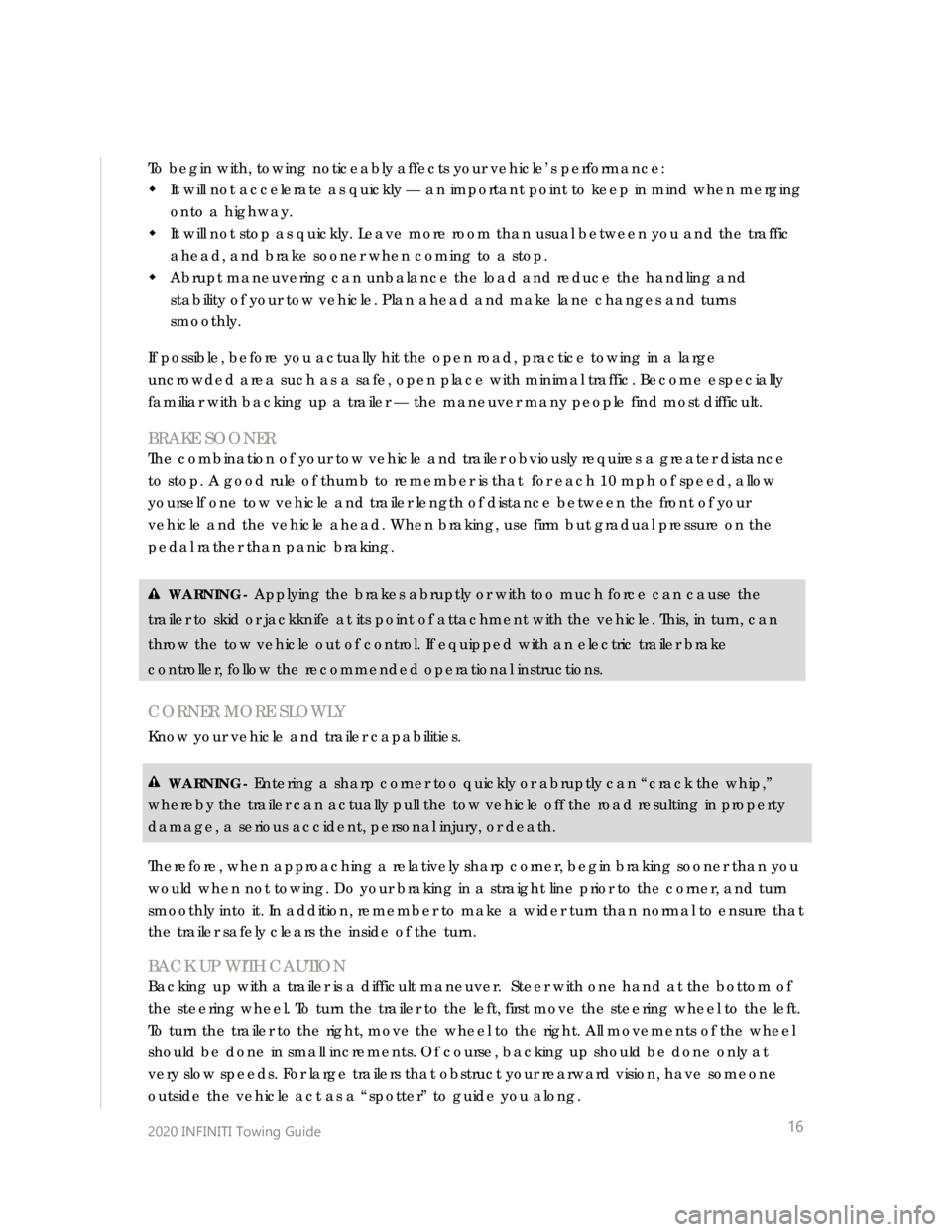
2020 INFINITI Towing Guide
16
To begin with, towing noticeably affects your vehicle’s performa nce:
It will not accelerate as quickly — an important point to keep in mind when merging
onto a highway.
It will not stop as quickly. L eave more room than usual between you and the traffic
ahead, and brake sooner when coming to a stop.
Abrupt maneuvering can unbalance t he load and reduce the handling and
sta bility of your tow vehicle. P lan ahead and make lane changes and turns
smoothly.
If possible, before you actually hit the open road, practice towing in a large
uncrowded area such as a safe, open place with minimal traffic. Become especially
fam iliar with backing up a trailer — t he maneuver many people find most difficult.
BRAKE SOONER
The combination of your tow vehicle and trailer obviously requires a greater distance
to stop. A good rule of thumb to remember is t hat for each 10 mph of speed, allow
yourself one tow vehicle and trailer length of distance between the front of your
vehicle and the vehicle ahead. When braking, use firm but gradual pressure on the
pedal rather than panic braking.
WARNING - Applying the brakes abruptly or with too much force can cause the
trailer to skid or jackknife at its point of attachment with the vehicle. This, in turn, can
throw the tow vehicle out of control. If equipped with an electric trailer brake
controller, follow the recommended operational instructions.
CORNER MORE SLOWLY
Know your vehicle and trailer capabilities.
WARNING - Entering a sharp corner too quickly or abruptly can “crack the whip,”
whereby the trailer can actually pull the tow vehicle off the road resulting in property
damage, a serious accident , personal injury, or death.
Therefore, when approaching a relatively sharp corner, begin braking sooner than you
would when not towing. Do your braking in a straight line prior to the corner, and turn
smoothly into it. In addition, remember to make a wider turn than normal to ensure that
the trailer safely clears the inside of the turn.
BACK UP WITH CAUTION
Backing up with a trailer is a difficult maneuver . Steer with one hand at the bottom of
the steering wheel. To turn the trailer to the left, first move the steering wheel to the left.
To turn the trailer to the right, m ove the wheel to the right. All movements of the wheel
shou ld be done in small increm ents. Of course, backing up should be done only at
very slow speeds. For large trailers that obstruct your rearward vision, have someone
outside the vehicle act as a “spotter” to guide you along.
Page 18 of 25
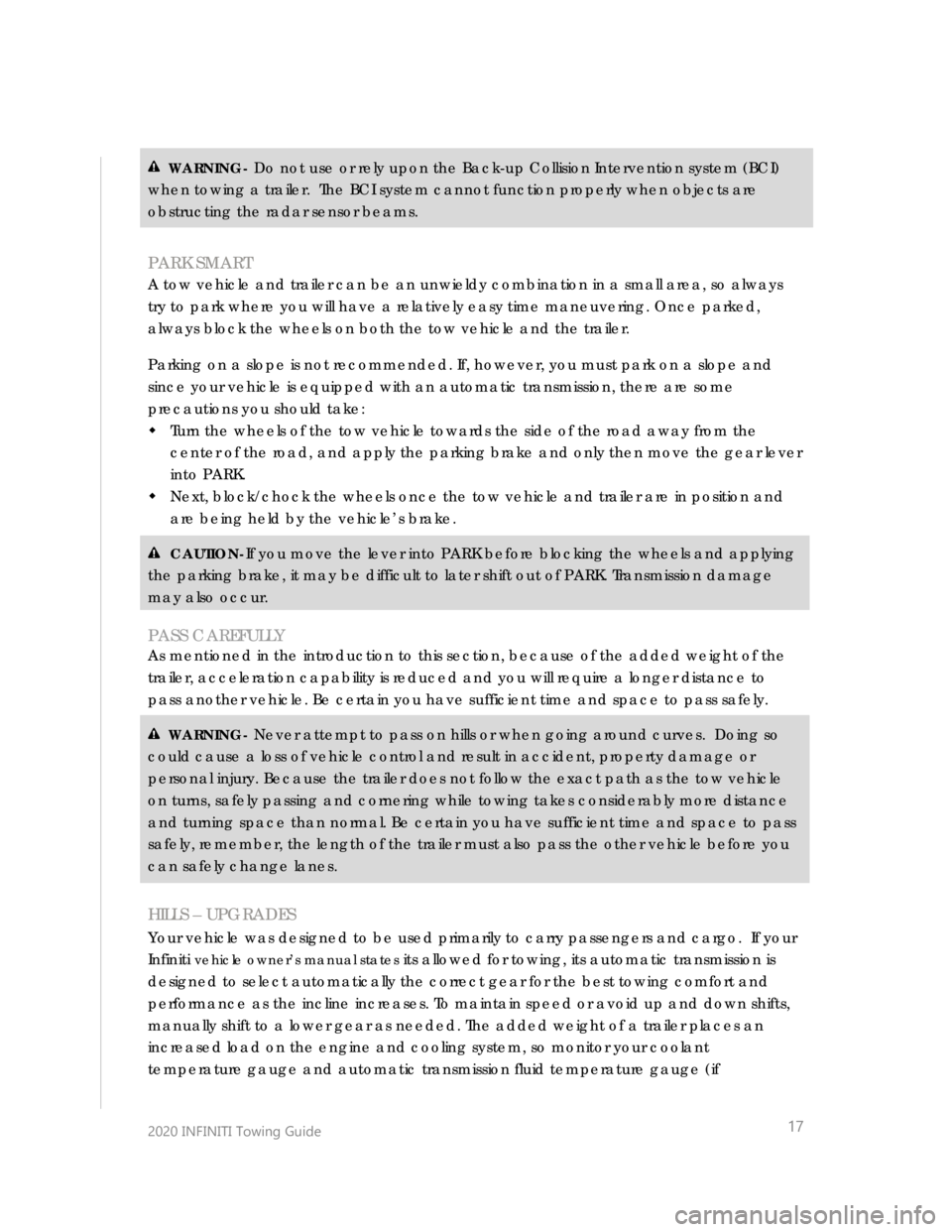
2020 INFINITI Towing Guide
17
WARNING- Do not use or rely upon the Back-up Collision Intervention system (BCI)
when towing a trailer. The BCI system cannot function properly when objects are
obstructing the radar sensor beams.
PARK SMART
A tow vehicle and trailer can be an unwieldy combination in a sma ll area, so always
try to park where you will have a relatively easy time maneuvering. Once parked,
always block the wheels on both the tow vehicle and the trailer.
Parking on a slope is not recommended. If, however, you must park on a slope and
since y our vehicle is equipped with an automatic transmission, there are some
precautions you should take:
Turn the wheels of the tow vehicle towards the side of the road away from the
center of the road, and apply the parking brake and only then move the gear lever
into PARK.
Next, block /chock the wheels once the tow vehicle and trailer are in position and
are being held by the vehicle’s brake.
CAUTION- If you move the lever into PARK before blocking the wheels and applying
the parking brake, it may be difficult to later shift out of PARK. Transmission damage
may also occur.
PASS CAREFULLY
As mentioned in the introduction to this section, because of the added weight of the
trailer, acceleration capability is reduced and you will require a longer distance to
pass another vehicle. Be certain you have sufficient time and space to pass safely.
WARNING - Never attempt to pass on hills or when going around curves. Doing so
could cause a loss of vehicle control and result in accident , property damage or
personal injury. Because the trailer does not follow the exact path as the tow vehicle
on turns, safely passing and cornering while towing takes considerably more distance
and turning space than normal. Be certain you have sufficient time and space to pass
safely , remember, the length of the trailer must also pass the other vehicle before you
can safely change lanes.
HILLS – UPGRADES
Your vehicle was designed to be used primarily to carry passengers and cargo. If your
Infiniti
vehicle owner’s manual states its allowed for towing, its automatic transmission is
designed to select automatically the correct gear for the best towing comfort and
performance as the incline increases. To maintain speed or avoid up and down shifts,
manually sh ift to a lower gear as needed. The added weight of a trailer places an
increased load on the engine and cooling system, so monitor your coolant
temperature gauge and automatic transmission fluid temperature gauge (if
Page 19 of 25
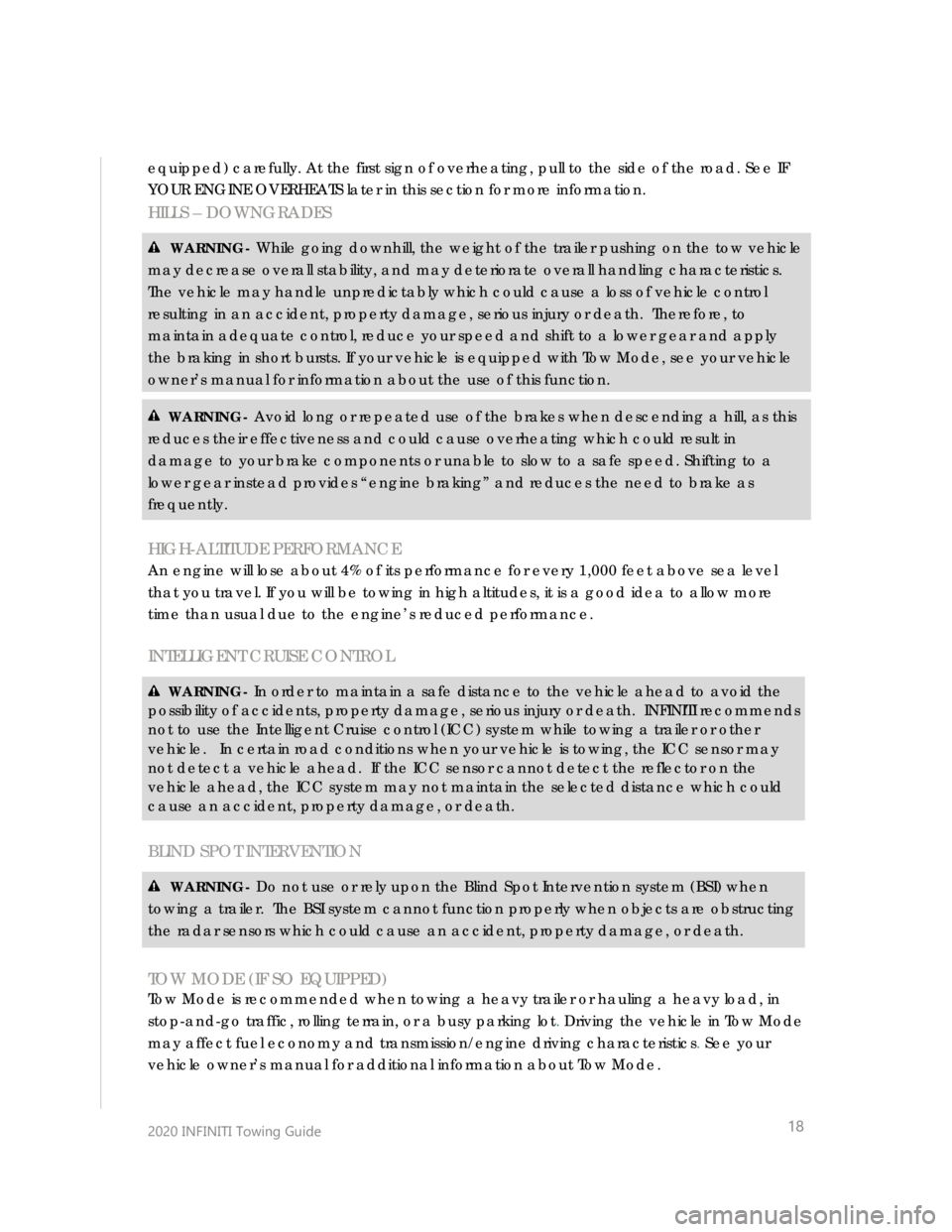
2020 INFINITI Towing Guide
18
equipped) carefully. At the first sign of overheating, pull to the side of the road. See IF
YOUR ENGINE OVERHEATS later in this section for more information.
HILLS – DOWNGRADES
WARNING - While going downhill, the weight of the trailer pushing on the tow vehicle
may decrease overall stability , and may deteriorate overall handling characteristics .
The vehicle may handle unpredictably which could cause a loss of vehicle control
result ing in an accident, property damage, serious injury or death. Therefore, to
maintain adequate control, reduce you r speed and shift to a lower gear and apply
the braking in short bursts . If your vehicle is equipped with Tow Mode, see your vehicle
owner’s manual for information about the use of this function.
WARNING- A void lon g or repea ted use of the brakes when descending a hill, as this
reduces their effectiveness and could cause overheating which could result in
damage to your brake components or unable to slow to a safe speed. Shifting to a
lower gear instead provides “engine braking ” and reduces the need to brake as
frequently.
HIGH- ALTITUDE PERFORMANCE
An engine will lose about 4% of its performance for every 1,000 feet above sea level
that you travel. If you will be towing in high altitudes, it is a good idea to allow more
time th an usual due to the engine’s reduced performance.
INTELLIGENT CRUISE CONTROL
WARNING- In order to maintain a safe distance to the vehicle ahead to avoid the
possibility of accidents, property damage, serious injury or death . INFINITI recommends
not to use the Intelligent Cruise control (ICC) system while towing a trailer or other
vehicle. In certain road conditions when your vehicle is towing, the ICC sensor may
not detect a vehicle ahead . If the ICC sensor cannot detect the reflector on the
vehicle ahead, the ICC system may not maintain the selected distance which could
cause an accident, property damage, or death.
BLIND SPOT INTERVENTION
WARNING - Do not use or rely upon the Blind Spot Intervention system (B SI) when
towing a trailer. The BSI system cannot function properly when objects are obstructing
the radar sensor s which could cause an accident, property damage, or death.
TOW MODE (IF SO EQUIPPED)
Tow Mode is recommended when towing a heavy trailer or hauling a heavy load, in
stop -and -go traffic, rolling terrain, or a busy parking lot. Driving the vehicle in Tow Mode
may affect fuel economy and transmission/engine driving characteristics. See your
vehicle owner’s manual for additional information about Tow Mode .
Page 20 of 25
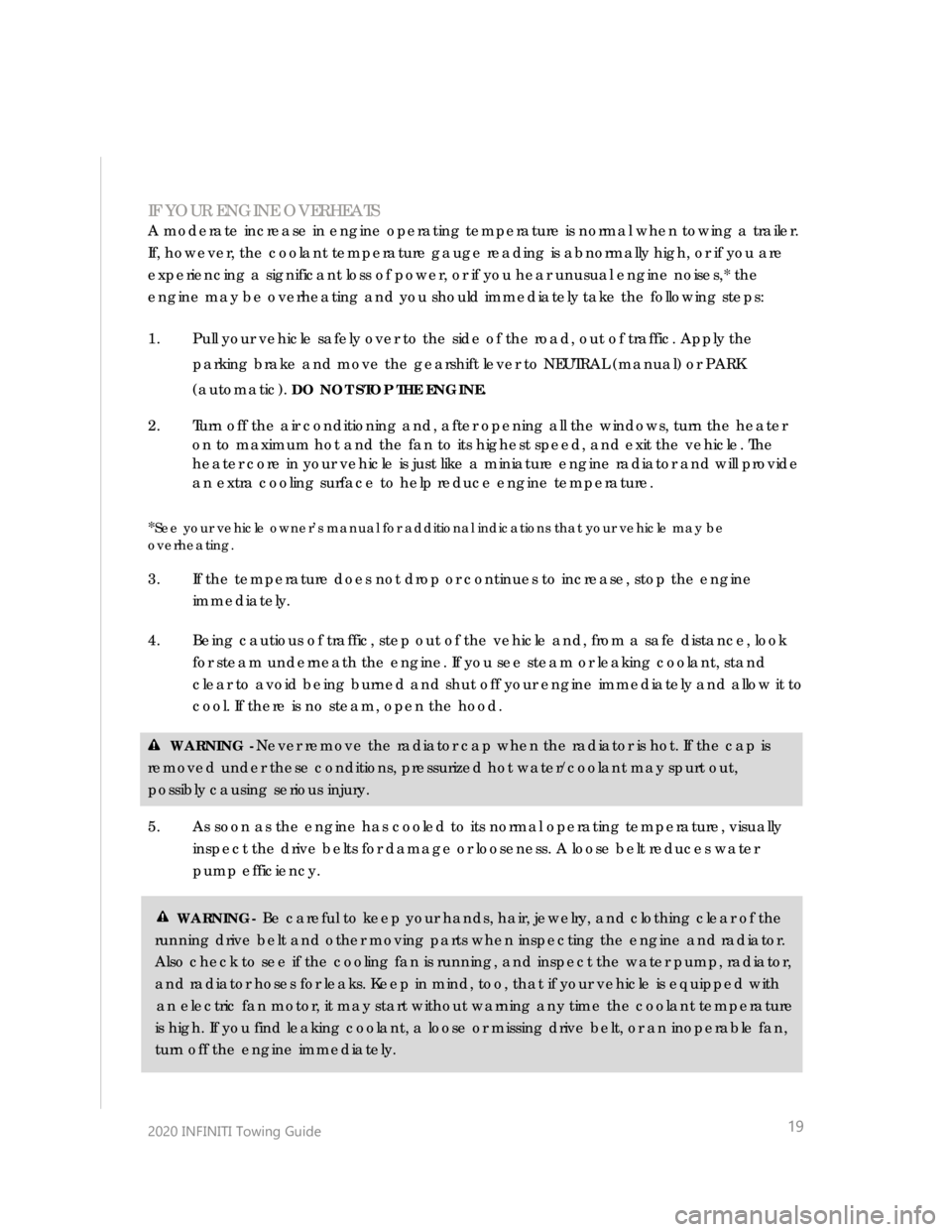
2020 INFINITI Towing Guide
19
IF YOUR ENGINE OVERHEATS
A moderate increase in engine operating temperature is normal when towing a trailer.
If, however, the coolant temperature gauge reading is abnormally high, or if you are
experiencing a significant loss of power, or if you hea r unusual engine noises,* the
engine may be overheating and you should immediately take the following steps:
1. Pull your vehicle safely over to the side of the road, out of t raffic. Apply the
parking brake and move the gearshift lever to NEUTRAL (manual) or PARK
(automatic). DO NOT STOP THE ENGINE.
2. Turn off the air conditioning and, after opening all the windows, turn the heater
on to maximum hot and the fan to its highest speed , and exit the vehicle. The
heater core in your vehicle is just like a miniature engine radiator and will provide
an extra cooling surface to help reduce engine temperature.
*See your vehicle owner’s manual for additional indications that your vehicle may be
overheating.
3. If the temperature does not d rop or continues to increase, stop t he engine
immediately.
4. Being cautious of traffic, step out of the vehicle and, from a safe distance, look
for steam underneath the engine. If you see steam or leaking coolant, sta nd
clear to avoid being burned and s hut off your engine immediately and allow it to
cool. If there is no steam, open the hood.
WARNING - Never remove the radiator cap when the radiator is hot. If the cap is
removed under these conditions, pressurized hot wate r/coolant may spurt out,
possibly causing seriou s injury.
5. As soon as the engine has cooled to its normal operating temperature, visually
inspect the drive belts for damage or looseness. A loose belt reduces water
pump efficiency.
WARNING - Be careful to keep your h ands, hair, jewelry, and clothing clear of the
running drive belt and other moving parts when inspecting the engine and radiator.
Also check to see if the cooling fan is running, and inspect the water pump, radiator,
and radiator hoses for leaks. Keep in m ind, too, that if your vehicle is equipped with
an electric fan motor, it may start without warning any time the coolant temperature
is high. If you find leaking coolant, a loose or missing drive belt, or an inoperable fan,
turn off the engine immediate ly.
Page 21 of 25
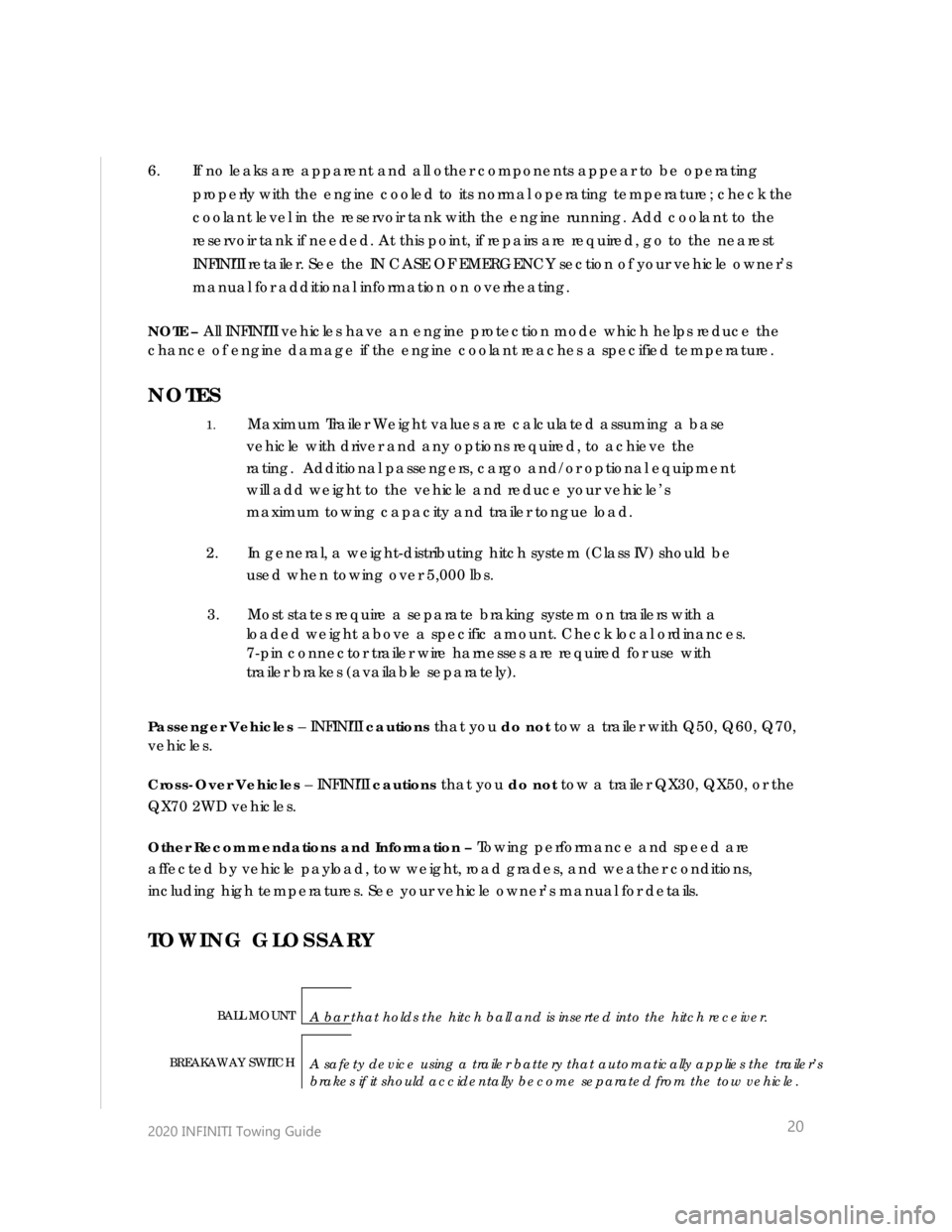
2020 INFINITI Towing Guide
20
6. If no leaks are apparent and all other components appear to be operating
properly with the engine cooled to its normal operating temperature ; check the
coolant level in the reservoir tank with the engine running. Add coolant to the
reservoir tank i f needed. At this point, if repairs are required, go to the nearest
INFINITI retailer . See the IN CASE OF EMERGENCY section of your vehicle owner’s
manual for additional information on overheating.
NOTE – All INFINITI vehicle s have an engine protection mo de which helps reduce the
chance of engine damage if the engine coolant reaches a specified temperature.
NOTES
Passenger Vehicles – INFINITI cautions that you do not tow a trailer with Q50, Q60, Q70 ,
vehicle s.
Cross- Over Vehic les – INFINITI cautions that you do not tow a trailer QX30, QX50, or the
QX70 2WD vehicles.
Other Recommendations and Information – Towing performance and speed are
affected by vehicle payload, tow weight, road grades, and weather conditions,
including h igh temperatures. See your vehicle owner’s manual for details.
TOWING GLOSSARY
BALL MOUNT A bar that holds the hitch ball and is inserted into the hitch receiver.
BRE AK AWAY SWI TCH A safety device using a trailer battery that automatically applies the trailer’s
brakes if it should accidentally become separated from the tow vehicle.
1. Maximum Trailer Weight values are calculated assuming a base
vehicle with driver and any options required, to achieve the
rating. Additional passengers, cargo and/or optional equipment
will add weight to the vehicle and reduce your vehicle’s
maximum towing capacity and trailer tongue load.
2. In general, a weight -distributing hitch system (Class IV) should be
used when towing over 5,000 lbs.
3. Most states require a separate braking system on trailers with a
loaded weight above a specific amount. Check local ordinances.
7- pin connector trailer wire harnesses are required for use with
trailer brakes (available separately).
Page 22 of 25
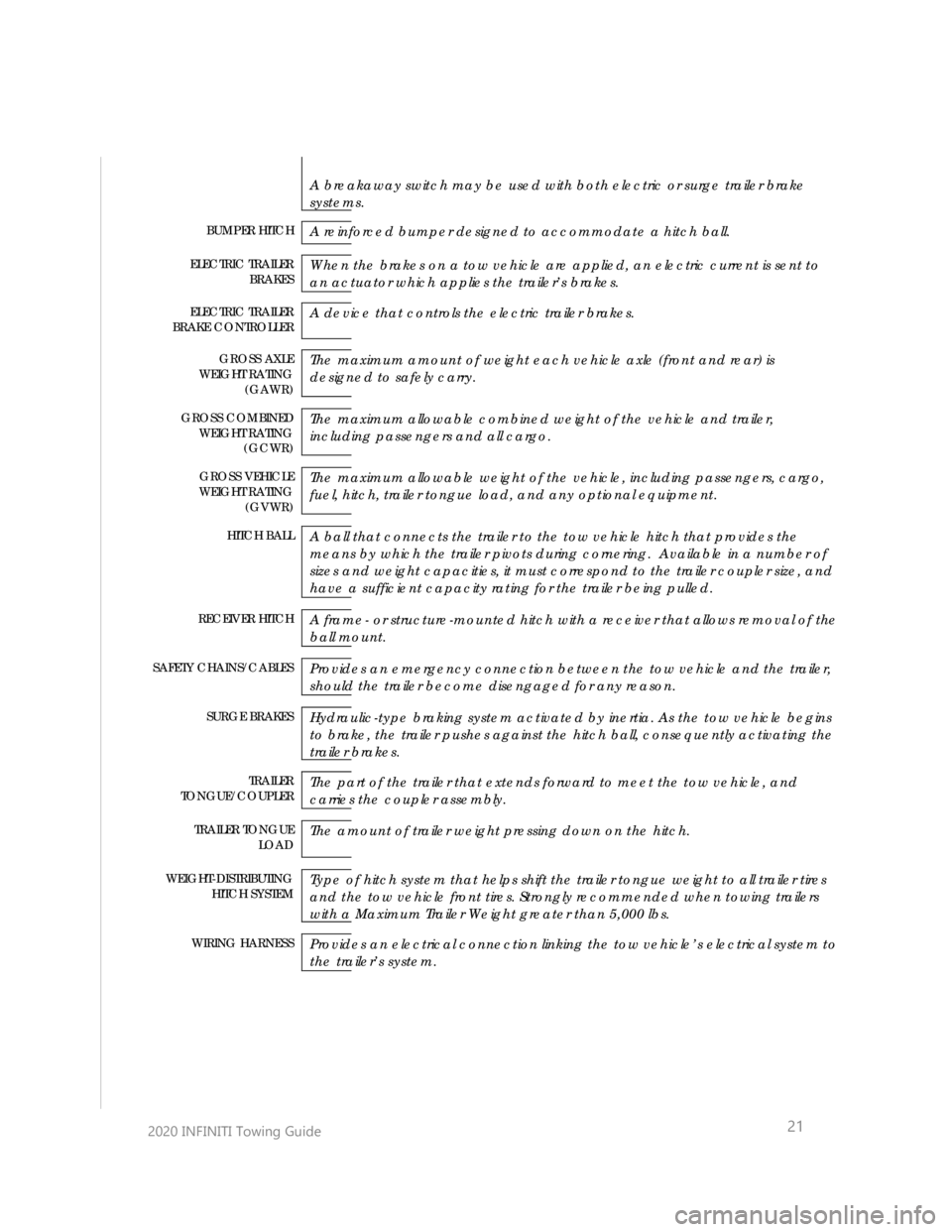
2020 INFINITI Towing Guide
21
A breakaway switch may be used with both electric or surge trailer brake
systems.
BUMPER HITCH A reinforced bumper designed to accommodate a hitch ball.
ELECTRIC TRAILER BR AKES When the brakes on a tow vehicle are applied, an electric current is sent to
an actuator which applies the trailer’s brakes.
ELECTRIC TRAILER BRAKE CONTROLLER A device that controls the electric trailer brakes.
GROSS AXLE WEIGHT RATING (GAWR)
The maximum amount of weight each vehicle axle (front and rear) is
designed to safely carry.
GROSS COMBINED WEIGHT RATING (GCWR)
The maximum allowable combined weight of the vehicle and trailer,
including passengers and all cargo.
GROSS VEHICLE WEIGHT RATING (GVWR)
The maximum allowable weight of the vehicle, including passengers, cargo,
fuel, hitch, trailer tongue load, and any optional equipment.
HITCH BALL A ball that connects the trailer to the tow vehicle hitch that provides the
means by which the trailer pivots during cornering. Available in a number of
sizes and weight capacities, it must correspond to the trailer coupler size, and
have a sufficient capacity rating for the trailer being pulled.
RECEIVER HITCH A frame- or structure-mounted hitch with a receiver that allows removal of the
ball mount.
SAFETY CHAI NS/CABLES Provides an emergency connection between the tow vehicle and the trailer,
should the trailer become disengaged for any reason.
SURGE BRAKES Hydraulic-type braking system activated by inertia. As the tow vehicle begins
to brake, the trailer pushes against the hitch ball, consequently activating the
trailer brakes.
TRAILER TONGUE/COUPLER The part of the trailer that extends forward to meet the tow vehicle, and
carries the coupler assembly.
TRAILER TONGUE LOAD The amount of trailer weight pressing down on the hitch.
WEIGHT-DISTRIBUTING HITCH SYSTEM Type of hitch system that helps shift the trailer tongue weight to all trailer tires
and the tow vehicle front tires. Strongly recommended when towing trailers
with a Maximum Trailer Weight greater than 5,000 lbs.
WI RI NG HARNESS Provides an electrical connection linking the tow vehicle’s electrical system to
the trailer’s system.